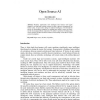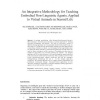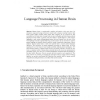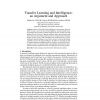AGI
2008
14 years 27 days ago
2008
Abstract. This paper presents a model of intelligence based on principles introduced by Piaget and the interactivist framework. It focuses on embodiment and sensory-motor aspects o...
AGI
2008
14 years 27 days ago
2008
Understanding why the original project of Artificial Intelligence is widely regarded as a failure and has been abandoned even by most of contemporary AI research itself may prove c...
AGI
2008
14 years 27 days ago
2008
: There are several approaches to emotions in AI, most of which are inspired by human emotional states and their arousal mechanisms. These approaches usually use high-level models ...
AGI
2008
14 years 27 days ago
2008
Machines significantly more intelligent than humans will require changes in our legal and economic systems in order to preserve something of our human values. An open source design...
AGI
2008
14 years 27 days ago
2008
A teaching methodology called Imitative-Reinforcement-Corrective (IRC) learning is described, and proposed as a general approach for teaching embodied non-linguistic AGI systems. I...
AGI
2008
14 years 27 days ago
2008
Every agent aspiring to human level intelligence, every AGI agent, must be capable of a theory of mind. That is, it must be able to attribute mental states, including intentions, t...
AGI
2008
14 years 27 days ago
2008
We give a brief overview of the main characteristics of diagrammatic reasoning, analyze a case of human reasoning in a mastermind game, and explain why hybrid representation system...
AGI
2008
14 years 27 days ago
2008
Human brain is exceptionally complex and simple at the same time. Its extremely composite biological structure results itself in human everyday behavior that many people might cons...
AGI
2008
14 years 27 days ago
2008
In order to claim fully general intelligence in an autonomous agent, the ability to learn is one of the most central capabilities. Classical machine learning techniques have had ma...
AGI
2008
14 years 27 days ago
2008
Abstract. An artificial system that achieves human-level performance on opendomain tasks must have a huge amount of knowledge about the world. We argue that the most feasible way t...





